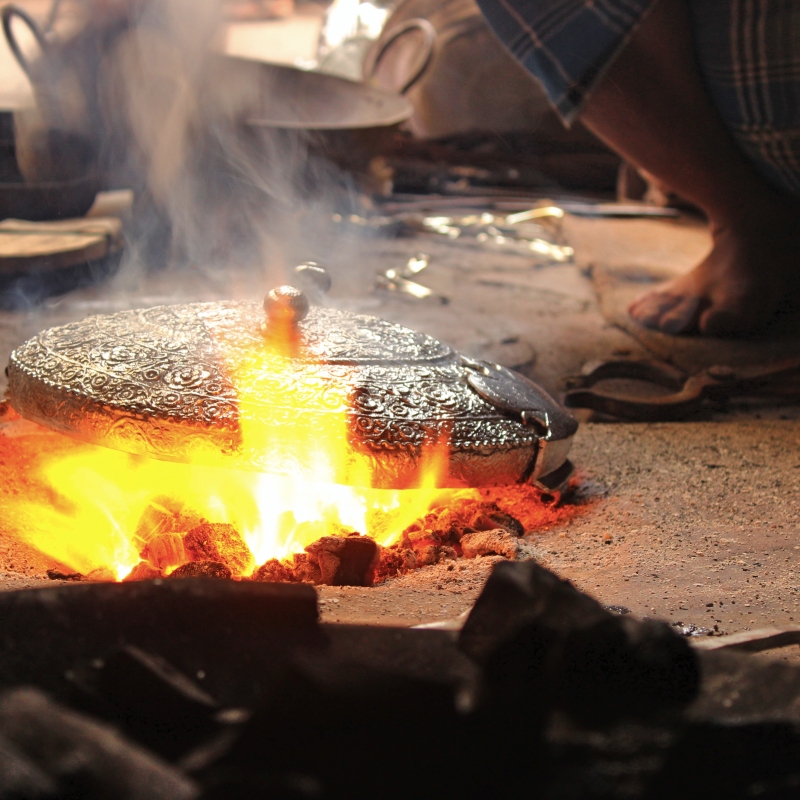“Bhande qalai kara lo! (Get your utensils tinned!)”
The qalaigars’ reverberating call in the galis of old Delhi, announcing their trade is an almost disappeared auditory phenomenon that was once the most banal and everyday of sounds of the old city. And so we head to the qalaigars of Matia Mahal to find out more about this diminishing trade.
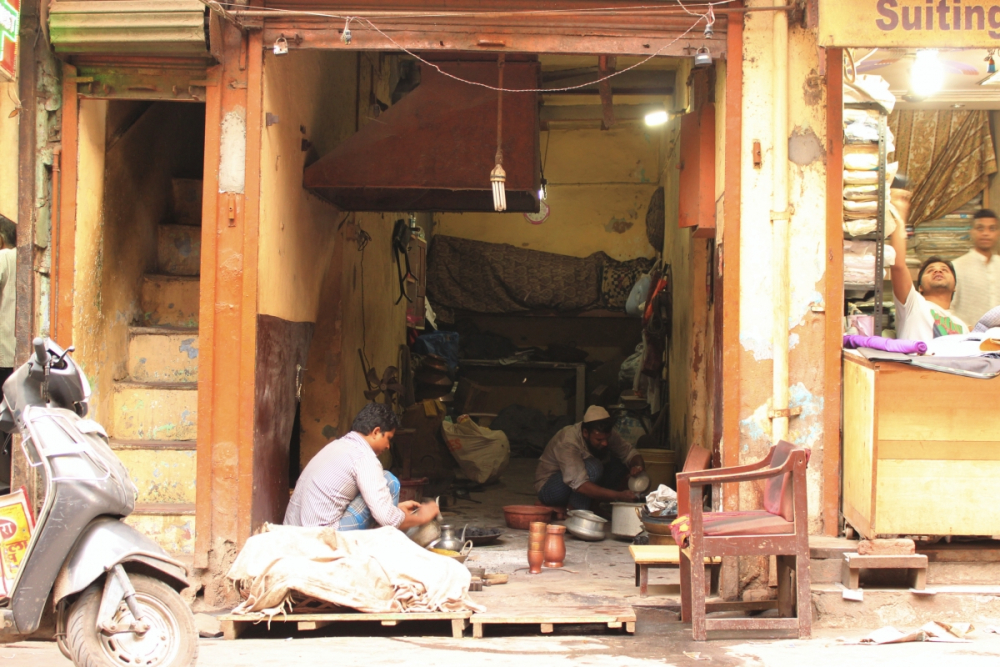
Some of the last few qalaigars that are left in the old city, the qalaigars’ dukaan in Matia Mahal is more than a hundred years old. A shop that is more often than not lost in the bustling market of Matia Mahal is nondescript to the extent that it’s very easy to miss it. After having walked right past it the first time, we retraced our steps and finally reached our destination. Located right opposite the famous Kallan Bawarchi, the shop is exhaling white smoke and hissing water.
At work are the two brothers, Mohammad Faisal and Mohammad Zeeshan. Dilliwalas for more than four generations now, their family has been in this line of trade for three generations, having worked from this very same shop since the very beginning.
The process of qalai principally entails the tinning of copper and brass utensils so that they can be used for cooking, eating and drinking water. Copper is one of the best metals for conducting heat and was therefore one of the traditional metals that were used to make cooking vessels. In copper vessels, the heat would spread evenly across the surface of the utensil, thereby cooking the food thoroughly. The metal, however, reacted with acidic foods to produce toxins that could result in food becoming discoloured, tasting bitter or even at times leading to food poisoning. So, in workshops like these the pots were lined with tin on the inside to prevent them from reacting with acidic food. Since the tinning process had to be repeated every few months, the art of qalai was inextricably associated with the kitchens of old Delhi and was an indispensible trade. From royal bawarchikhanas to regular households, qalaigars served the whole social spectrum of the old city.
The onset of the infiltration of aluminium and stainless steel in Indian kitchens however, altered their fates forever. Driven by the Nehruvian vision of ‘modern’ India, early decades of independence witnessed huge government subsidies propelling the industrialization of young India. The aluminium and steel industry flourished thus, steel being quintessential to the idea of ‘modern’ and seeds of stainless steel becoming one of the defining characters of Indian middle-class kitchens were sown. “The middle-class love affair with the modern took wing with stainless steel,” writes Santosh Desai, an established social commentator in his book, Mother Pious Lady: Making Sense of Everyday India.
In the kitchens of old Delhi, much like the kitchens elsewhere in India, first aluminium and then stainless steel took precedence over traditional copper and brass vessels. Stainless steel offered long lasting durability, strength, light weight and its ‘ever-silver’ aesthetics boasting its non-corrosive nature. This was pitted against the high maintenance of polishing, cleaning and tinning required by traditional metals, and the former clearly appeared to be emerging victorious. It’s popularity rose despite the oddity that stainless steel wasn’t actually well suited for cooking for it didn’t conduct heat as well as copper nor did it retain heat as well as brass or cast iron. Yet, its easy maintenance was too compelling to ignore.
Largely substituted with stainless steel and aluminium for everyday kitchen use, by the end of the 20th century, copper and brass utensils were almost entirely relegated to being material possessions that would see the light of the day very rarely. Though interestingly, they continued to be an important part of wedding trousseaus and would be used on special occasions especially in Muslim households, as copper remained a valued metal. But as they disappeared from everyday use, the need for qalai dwindled down to a slow trickle.
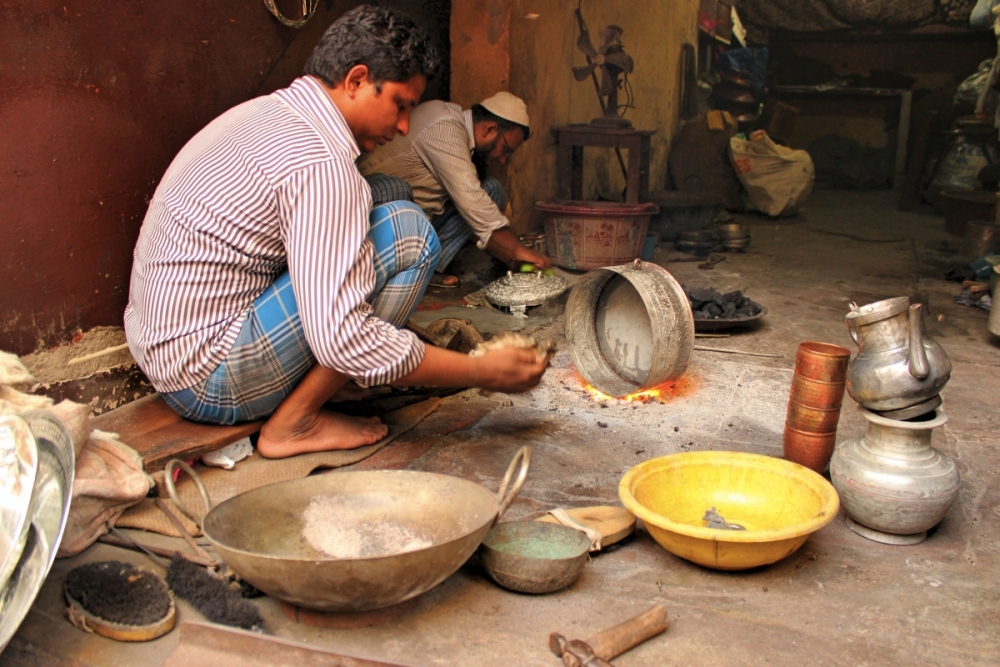
However, in the recent years, there has been some amount of revival in terms of the use of copper and brass utensils. Concomitantly, qalai work also experienced relative resurgence. Mohammad Zeeshan informs us that about 10-15 year ago, qalai work was on the brink of vanishing completely and their family had decided to switch to a more profitable profession like most other qalaigars. But eventually, “Allah ka shukr hai (thanks be to God)”, he says, owing to a recent increase in the awareness of the benefits of using copper utensils and the consequent demand for qalai has helped the sustenance of their skill. Listing some of these benefits he states that food cooked in copper utensils is said to have better taste as the evenly distributed heat cooks the food better and it ensures that your digestive system is in the right order. For instance, he explains further, “In both Hindu and Muslim households of the old city, patilis made from traditional metals were used and people would fall sick less often, unlike nowadays wherein people fall sick more often thanks to aluminium pressure cookers.” While of course aluminium pressure cookers aren’t the only source of our health miseries, there is substantial weight in his claim. Relative to aluminium, copper vessels have anti-microbial properties and help fight against many gastrointestinal diseases, which help keep the digestive system healthy amongst other health benefits. And it is these benefits, promoted through hakims practicing Unani medicine, that the use of traditional metals and the work qalai owes its bit of revival. A current resident of the old city shares that in her house they now use a copper jug to store drinking water upon the suggestion of a local hakim whose diagnosis and remedies they have a lot of faith in. Water stored in copper utensils is said to have medicinal value for copper has antimicrobial properties which helps maintain blood pressure and is also good for diabetic patients. In fact, it is not uncommon to still find tambe ke katore for drinking water in Muslim families of Delhi, both current and former residents of the old city.
Despite the resurgence, Mohammad Zeeshan is not overly optimistic about the future of qalai. Unsure of the longevity of this revival, there are other factors like inflation to be considered. Raw materials like coal and tin have become very expensive and returns are not always profitable. Also, the work needs high levels of energy for it demands constant physical labour for almost eight to ten hours a day apart from considering the equally long exposures to heat and fumes. As a result, the youngest brother of the family, Mohammad Faizan has taken to another line of business and owns a retail shop of garments.
Besides, the usage of qalai in today’s time has a certain class factor to it for not everybody can afford to use utensils that require re-tinning every few months. Ms. Farhat Ara, a resident of the old city, elucidates on the use of copper vessels for everyday cooking purposes. “The maintainence of tambe ke bartan is very high”, she states. “Not only has it become very expensive, the kind of qalai that is done these days is very unreliable and begins to wear off within a few times of use”, she complains.
One of the last few qalaigars of the old city, these brothers primarily cater to the commercial needs of neighboring hotels and bawarchikhanas. Kallan bawarchi and the nearby Karim Hotel are two of their prime customers. They also serve the domestic needs of tinning utensils of the handful of households in the old city that use vessels made of traditional metals. While customers are not restricted only to the old city, there are some people from other parts of Delhi that also get their utensils tinned, they usually are former residents of the old city. However, the primary demand of these customers is to get copper utensils tinned not so much for everyday use as it is for wedding trousseaus and gifts. Though as spaces shrink in Delhi, some families are even forgoing this tradition.
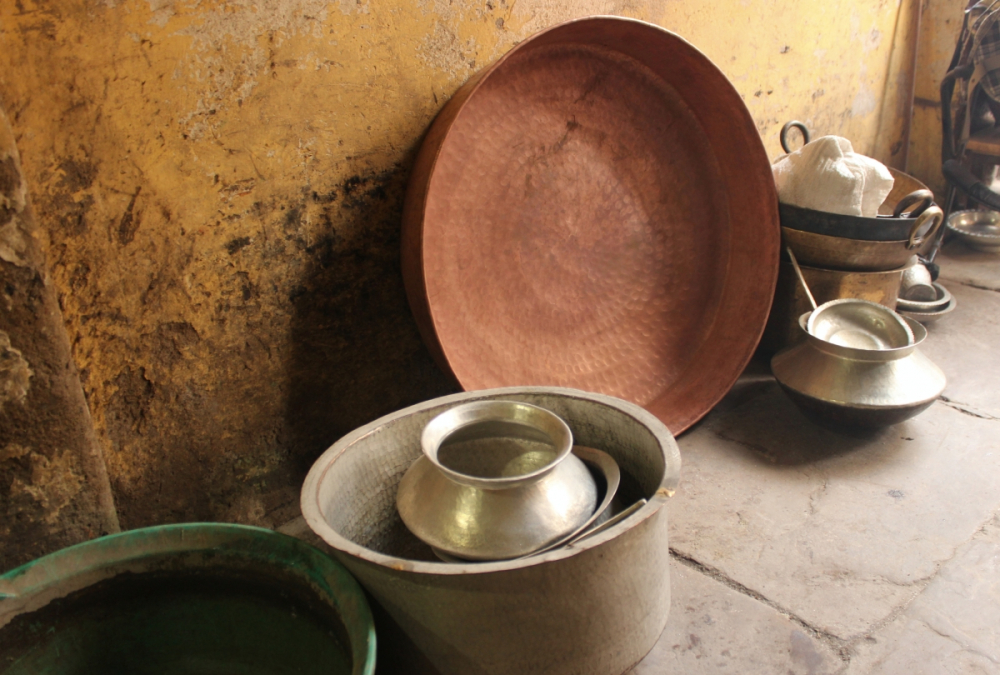
An interesting observation reveals that most of the copper vessels at the shop with intricate chetai work belong to Muslim households who get both the inside and the outside of the vessel tinned. Whereas the bare brass taslas kept against the wall have been asked to be tinned only on the inside and belong to a Hindu family.
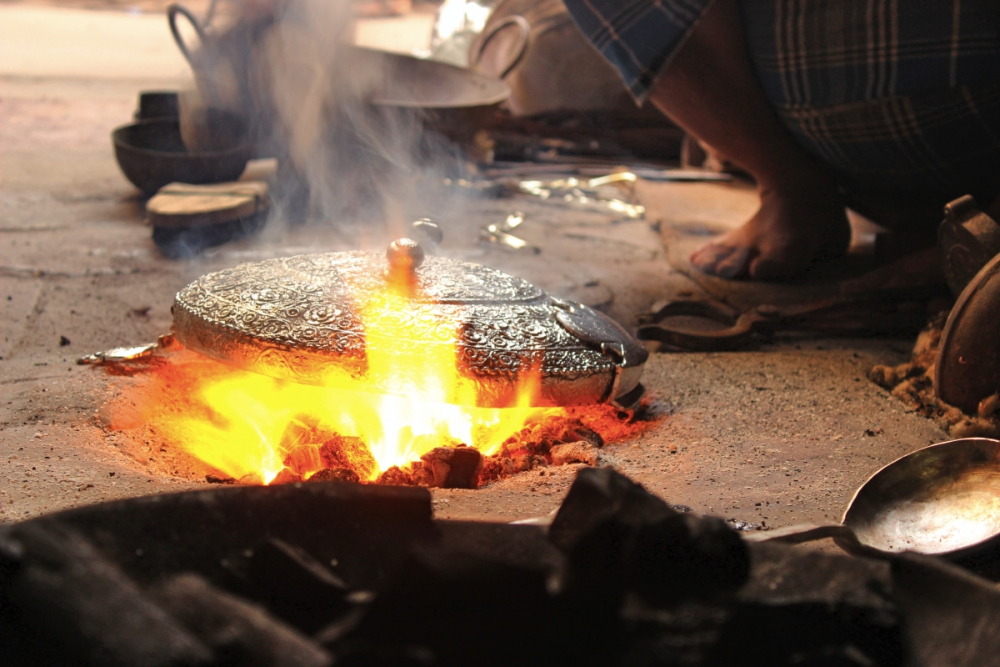
Despite its dubious destiny, the art of qalai, as visually illustrated by Mohammad Faisal, is fascinating. First the utensil is heated over a fire fuelled by coal and the rotation of a fixed iron fan on the floor and is rubbed clean with a cotton pad to get rid of surface impurities. This is followed by putting a tiny piece of tin on the blasting hot surface of the vessel, which instantly melts and is then rubbed with a blackened cotton pad dipped in nausadar (ammonium chloride) powder on the utensil. Consequently, an evenly spread lining of tin is formed on the surface. The result is visually magical for within a matter of minutes emerges a shinning utensil almost as good as brand new if not better. The nausadar powder is responsible for the white smoke that engulfs the shop. And the hissing sound is the newly tinned scalding hot vessel being dipped in water for it to cool down.
Mohammad Zeeshan claims that the fumes of the nausadar powder are not hazardous to health citing the health of his father and grandfather as examples. “Though as a precaution, our grandfather has instructed us to eat gud (jaggery) after work, a gharelu nuska (household remedy) to keep the lungs clean”, he states as a matter of fact. He is also quick to add, given the current horrifying pollution levels of Delhi that these fumes, which find an escape route through the chimney above are not very polluting. “We have our licenses approved by the municipal corporation,”, he expounds further, “they even conducted a pollution check, and we were given a clearance!”
One cannot look at old copper vessels and not appreciate their intricate designing. Chetai is the art of crafting copper wares and is a part of an age-old tradition. Unfortunately, “the karigars of Dilli are not here anymore”, Mohammad Zeeshan informs us solemnly. “The kind of gehri chetai that used to be done before doesn't happen anymore. When the use of copper utensils itself waned, how would there be chetai artisans left?” he asks. “We usually get utensils with very minimal chetai, as against the rare times when a really old utensil comes that has very detailed designing”, he finishes.
Will the qalaigars of Shahjahanabad standing at the periphery of relevance today meet the same fate? Slowly ebb away from the social landscape of the old city of Delhi? Only the mighty Time will tell.
